| 1 | Aesculapian snake |
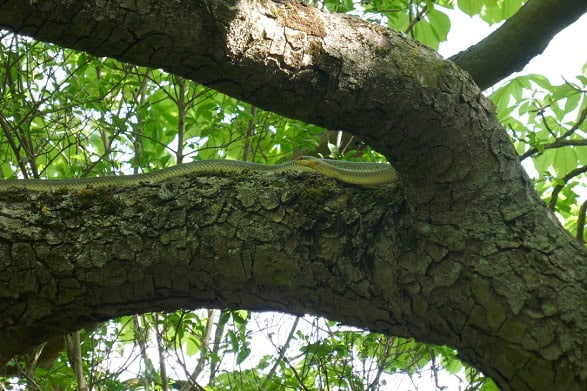
The most tree-loving snake in Italy, and one of Italy’s longest snakes, reaching a maximum of 2 metres (excluding real mutants). Aesculapian snakes prey on mammals such as bank voles and black rats, and inhabit forests both dark and sparse. They’re a species surrounded by folklore, as they were named after the god of healing Asclepius, who supposedly built healing temples where they slithered over patients while they slept.
While grass snakes are completely fluent in ponds and small streams, the Aesculapian snake is perfectly fluent in tall trees. They ascend trees with ease, whether it’s in a full forest or an isolated tree clump by a school. Part of this is experience, but most of it is instinct developed over millions of years. Aesculapian snakes are a harmless constrictor, which lacks any form of venom. Nobody has died at their hand in recorded history.
This species normally stays calm when humans approach, and never moves too fast. They look calm the majority of the time, as though they realise that their tree-climbing skills give them an inherent advantage which nobody can take away. Aesculapian snakes are much more at home in trees than humans can hope to be, except maybe when it comes to cutting them down.
| 2 | Ruschenberg’s tree boa |
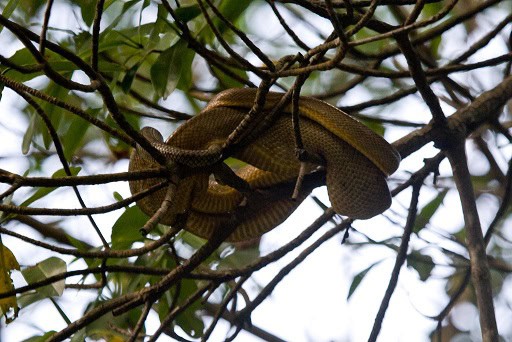
A relative of the Amazon tree boa, the ringed tree boa, and other Corallus tree boa members. This species is particularly common on Trinidad, where it hisses at people from eye level, specifically on a tree branch perch. This is a non-venomous constrictor which crosses open ground if necessary to find a more bountiful ambush site, but prefers to stay in trees all day, whether at mid-height or 10 metres high in the canopies. Corallus ruschenbergii is encountered regularly by Trinidad locals, who dub it the “dormillion”.
Ruschenberg’s tree boas measure up to 2 metres and are relatively thin for a constrictor, to balance effectively on branches. This tree snake mainly preys on rodents, and is 100% non-venomous, but can be highly aggressive if aggravated.
As a nocturnal snake, Ruschenberg’s tree boa can be tricky to spot, but there’s a great secret – their eyes reflect torchlight incredibly well. This is a trait found in most Corallus tree boas. Scan around with your handheld light beam and a pair of glowing white coins may appear in a tree, side by side, followed by a hissing serpent manifesting as though they’ve just teleported.
| 3 | Western mangrove catsnake |
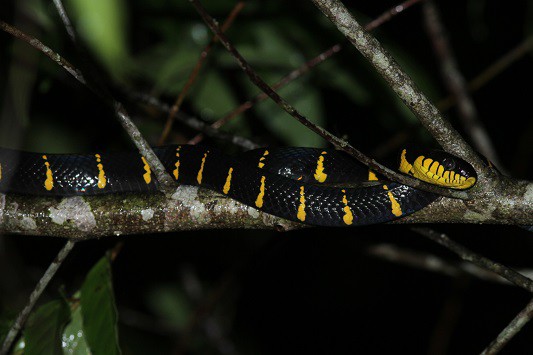
A southeast Asian tree snake which measures up to 2.8 metres. Western mangrove catsnakes (Boiga melanota) are common in southern Thailand, peninsular Malaysia, Singapore and Sumatra, and are extremely easy to recognise due to their yellow-black colours.
This species has caused no confirmed deaths, but since 2000, several neurotoxins have been discovered in its venom: irditoxin, boigatoxin-A, and denmotoxin. These act similarly to a black mamba’s, albeit to a dramatically weaker extent. Another study found that its diet was incredibly flexible, with 54 prey items including 15 lizards, 7 snakes, 13 birds and 17 mammals. These discoveries were fairly recent, but one fact has been known for hundreds of years: that mangrove catsnakes love to rest in trees.
A mangrove catsnake will never snap a branch and plummet to the hard forest floor, nor let its mind wander and fall down. If faced with a choice of escape, upwards into trees or downwards into a dark burrow, they’ll take upwards any day, whereas a king cobra would always rather go downwards. Boiga melanota can appear both in deep forests and in trees close to towns and villages.
Mangrove catsnakes aren’t completely inflexible, as they like the ground, but they simply love being in trees. The venom delivery is rear-fanged, and they struggle to inject more than mere droplets without extensive chewing, but in a 1991 report, a keeper who was bitten experienced fatigue, listlessness, kidney pain, a metallic taste, nausea and intense pain. If you see one plummeting toward your face, getting larger and larger, you’re not about to die; just rip away the snake before it can begin to chew on your nose.
| 4 | Saw-toothed necked bronzeback |
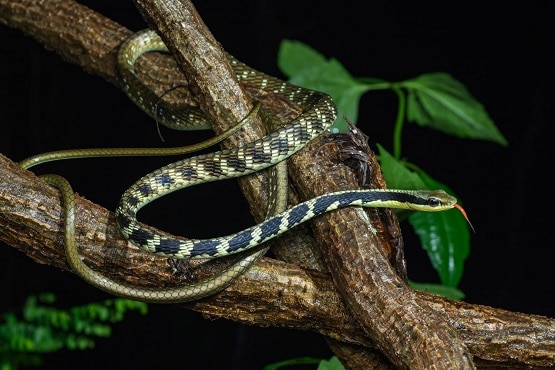
A 80-100cm Thai species which preys mainly on frogs, similarly to other bronzeback members. Sawtooth-necked bronzebacks (Dendrelaphis nigroserratus) are found exclusively in western and southern Thailand, possibly over the border in Myanmar, and were only confirmed as an independent species in 2012.
It’s common to see this harmless snake intertwined with a thin branch, with jungle colours that almost resemble a tiny alien creature. They’d stand no chance in a war with monocled cobras and oriental ratsnakes, and that’s why they’ve chosen their humble branch niche instead. Sawtooth-necked bronzebacks are found on branches in forests about two thirds of the time, usually 1-2 metres above ground. They stray to the ground occasionally, but tree branches are where all their skills of nimbleness, balance and agility come to the fore.
Sawtooth-necked bronzebacks rest on incredibly thin branches like a tightrope walker, applying several spaghetti coils for support. Their perspective is different, as the branches they rest on only look tiny to us humans. To Dedrelaphis nigroserratus, these branches look as welcoming as a small footbridge across a stream – perfectly easy to navigate with the slightest concentration.
| 5 | Common Madagascar cat snake |
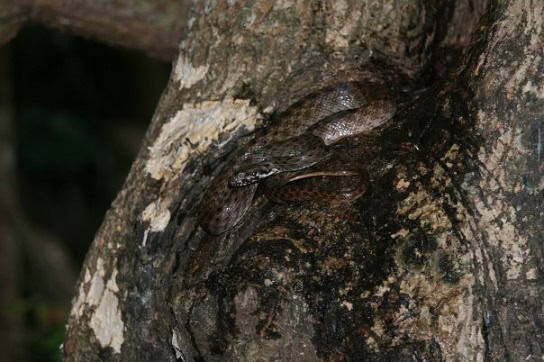
Madagascar’s main tree snake. This is a thin-bodied species which weaves along thin branches, and rapidly accelerates if necessary. They average at 90-100cm, and inhabit most of Madagascar, from north to south. Rather than green camouflage, they rely on speed and nimble acrobatics for their survival. This snake varies from brown to yellow to silver.
Rather than deep rainforests, common Madagascar cat-eyed snakes (Madagascarophis colubrinus) are happy in degraded human zones. As long as tree clumps are standing, they can survive and thrive. They appear in trees in villages, gardens, outside town halls, near cocoa plantations. Building your dream house by a forest gives them a corridor directly to your bedroom windowsill.
Madagascar cat-eyed snakes have a supposedly mild venom, which nevertheless contains a neurotoxin called maculotoxin, discovered just last year (2023). However, the chances of being bitten are extremely low. Madagascarophis colubrinus drops to the ground when necessary, but they’re most at home on tree branches, for which every aspect of their body is fine tuned. They’re capable of stalking and grabbing prey on branches, including chameleons and hatchling birds.
| 6 | Mexican parrot snake |
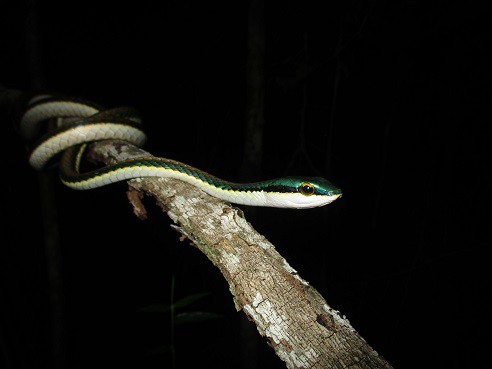
Part of the 19-member Leptophis family, the most common being the giant parrot snake. Mexican parrot snakes (Leptophis mexicanus) live from eastern Mexico to northwest Costa Rica, inhabiting 7 countries overall. While only mildly venomous, parrot snakes are infamous for their crazed facial expressions as they gape their mouths open wildly while trying to intimidate people. As a branch-dwelling snake, their demented face could be just inches from yours.
Mexican parrot snakes spend most of their day on branches, preferring moderately high perches rather than low bushes or 20 metres high. They prey on iguanas and anoles, and fully exploit their arboreal environments, investigating crevices in tree trunks for lurking prey. Mexican parrot snakes are completely familiar with their home tree, and know instantly when anything is inconsistent.
Guatemala has over 130 snake species, while Costa Rica has over 135. Flexible as snakes are, there’s no way they can all coexist in the same habitats without destroying each other. Consequently, Mexican parrot snakes have taken to branches to avoid the bushmasters and lanceheads prowling around below. Even here, they face competition from the likes of Imantodes tree snakes.
| 7 | Tiger ratsnake |
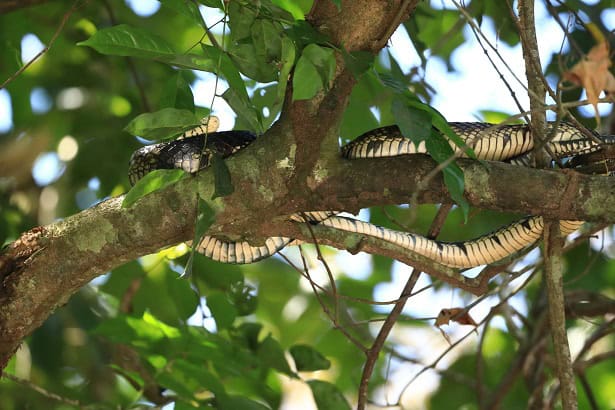
The tiger ratsnake (Spilotes pullatus) is a mega common snake which ranges from Mexico to Argentina, spanning the entirety of Central America and most of the Amazon region. Within those lands they can be found in a variety of places: the ground, roofs of houses, dark burrows, and resting comfortably on high branches with a content facial expression.
Tiger ratsnakes are a comfortable, confident species in the towering canopies of trees. They easily ascend vertical trunks, or leap between thin branches. One was found 13 metres high in a fig tree in Panama, and refused to come any lower than 12 metres. Trees are important for their life strategies, as the tiger ratsnake is a top bird’s nest raider. They’re confirmed to eat trogons and rufous-bellied thrushes, although one time, a gang of thrushes was seen mobbing a tiger ratsnake, causing it to retreat. Tiger ratsnakes also snatch Jamaican fruit bats and black mastiff bats from dark crevices in the roofs of houses, and by draping themselves over tall trees, they have a far superior view as to where these bats are hiding.
Even when hunting on the ground, tiger ratsnakes will drag their prey up trees to actually swallow them. One snake captured a fluffy Deppe’s squirrel, but wouldn’t begin feasting until it had ascended an additional 3 metres. Tiger ratsnakes are non-venomous and cannot kill a human, but are vicious if touched or provoked. Despite not being famous whatsoever, this is one of the Americas’ largest snake species, occasionally reaching 3 metres.
| 8 | Guatemalan palm pitviper |
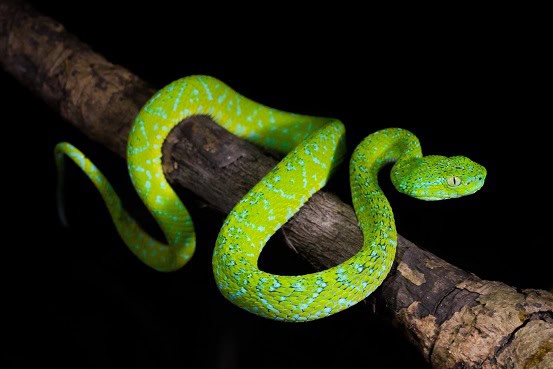
This venomous snake chose tree branches millions of years ago, and is now fully adapted to them. Guatemalan palm pitvipers (Bothriechis bicolor) measure 60-80cm and have a small range, inhabiting border areas between Guatemala and extreme southern Mexico. Here, they coexist with fer-de-lances and coral snakes, but are far less common than both. Bothriechis bicolor is an arboreal viper, preferring perches 1-2 metres high. They effortlessly coil around thin branches, remaining stationary in ambush position, and springing forward with propulsive force when prey (or a lost human explorer) wanders past.
Being rare, Guatemalan palm pitvipers don’t attack scores of people, but their bite isn’t something to take lightly. Forests near plantations are a danger zone, and the plantations themselves. Unlike a coral snake, eyelash viper venom is almost completely free from neurotoxins. In typical viper fashion, they specialise in cytotoxins (necrosis, swelling) and haemotoxins (spontaneous bleeding).
A 2020 IUCN report deemed them to be “vulnerable” to extinction. Guatemalan palm pitvipers can slither up a trunk coated with bark with ease. It’s not an obstacle even worth considering for them. Their body is relatively thick, but being just 60-80cm, they add relatively little weight.
| 9 | Green mamba |
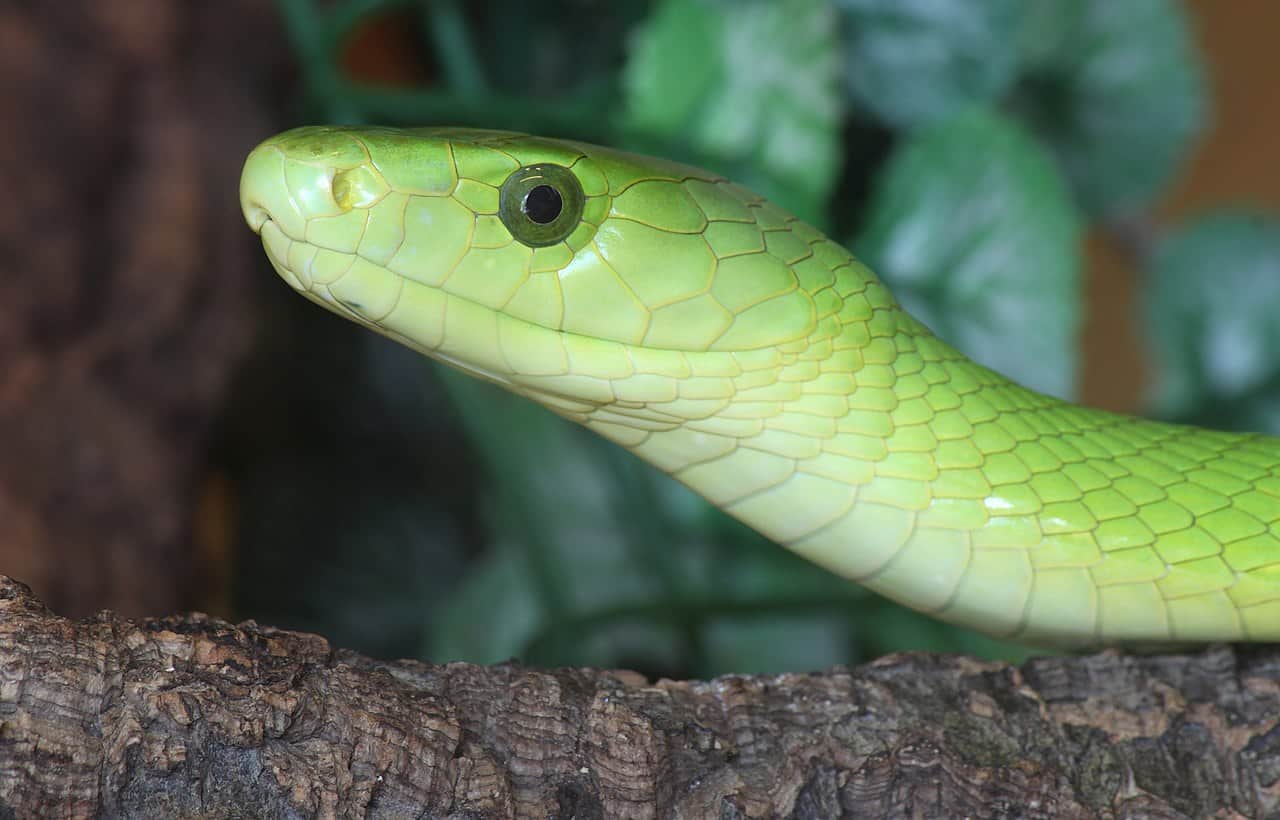
The black mamba’s cousin, which inhabits coastal southeastern Africa, and spends vastly more time in trees. Green mambas have speed when they need it, with a lightning strike and blinding lunge for bird prey. But unlike the twitchy black mamba, they’d much rather drape themselves peacefully over a branch all day. Their green colours make them tricky to spot for people wandering below, despite an average length of 1.5 metres.
Green mambas specifically choose areas of thickly overlapping branches, to create a protective cloak of foliage they can vanish into. They have a regular daily cycle: begin on high branches, shift a few metres downwards for an active ambush session, then retreat to the safety of the canopy later in the day. Every so often, they embark upon a longer migration to a fresh tree.
Because of their tree-dwelling lifestyle, bites are far rarer than with black mambas. Their venom contains the usual alpha-neurotoxins responsible for laboured breathing, but virtually no deaths have been recorded. The green mamba’s love of trees is reflected in its diet. Black mambas eat 81.5% mammals and 18.5% birds, but this ratio shifts towards birds in green mambas, at 42% versus 58% for mammals.
| 10 | Brown vine snake |
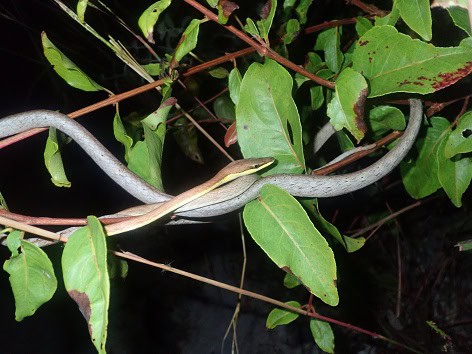
This 100cm (max 190cm) species lives near the green anaconda, but lives the opposite life. While the latter is bulky and cumbersome, the brown vine snake (Oxybelis aeneus) nimbly ascends branches with the agility of an acrobat. This species live in forests and their outskirts, sometimes scaring people by hissing from trees. It’s unknown whether this snake is dangerous to humans, though its cousin the green vine snake can cause pain and swelling. Brown vine snakes have a highly specialised venom, which is mildly toxic against mice and geckos, but significantly more lethal against Anolis lizards.
The brown vine snake takes mere minutes to climb a gnarly, warty rainforest tree. Being fully vertical on a trunk doesn’t bother them. Once perched on a branch, the brown vine snake will scan nearby trees for prey as well as the skies and ground for predators. This brown species has immense camouflage which perfectly mimics a parched branch. Their territory is massive, spanning Brazil, Venezuala, Columbia and French Guiana.
Brown vine snakes have the usual features for climbing trees, such as a thin body which minimises the weight at any given point. It’s unknown precisely how high they reach, whether towering at 20 metres or preferring 1-3 metre perches, but it would be surprising if they didn’t regularly exceed 10 metres.
